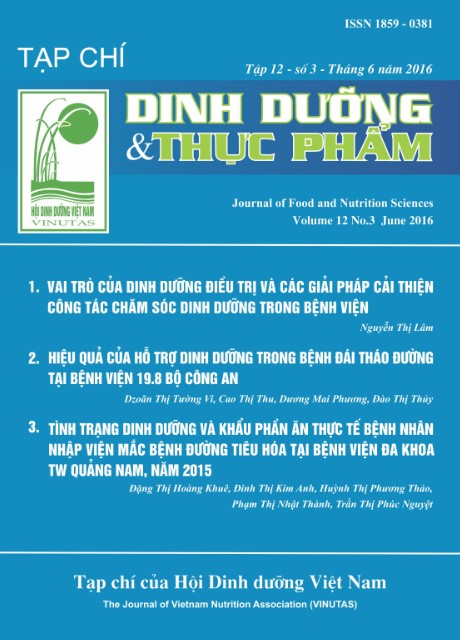NUTRITIONAL STATUS AND DIETARY INTAKE OF PATIENTS WITH GASTROINTESTINAL DISEASES IN QUANG NAM CENTRAL GENERAL HOSPITAL, 2015
Main Article Content
Abstract
Objective: Assessment of nutritional status and dietary intake of hospitalized patients with gastrointestinal diseases. Methods: A descriptive cross-sectional study on 276 patients hospitalized in gastroenterology ward of Quang Nam central general hospital was conducted. Nutrition assessment was made using BMI, SGA and food intake. Results:
The prevalence of underweight (BMI <18.5kg /m2) was 26.1%. The rate of risk of malnutrition according to SGA was 36.2%. Average energy intake was 1300 kcal/day meeting 76.4% of the RDA. The intake of vitamin A and C in the diet was low (212.9 mcg and 51.2 mg), meeting only 38.7% and 81.2% of the RDA. The intake of iron in the diet was very low (7.4g) meeting 40.9% of the recommendation. The ratio of Protein: Lipid: Carbohydrates was 17.3: 23.9: 58.8, which was imbalanced. Conclusion: Malnutrition was prevalent in newly hospitalized patients with gastrointestinal diseases. SGA method was the preferred method for assessing the risk of malnutrition for hospitalized patients. Dietary intake of the patients did not meet the recommendations. The data were the basis for the construction of a balanced and sufficient diet for those patients.
Keywords
Nutritional status, food intake, SGA
Article Details
References
2. Nguyễn Nhật Minh, Nguyễn Đỗ Huy (2013). Thực trạng dinh dưỡng của bệnh nhân tại bệnh viện đa khoa tỉnh Điện Biên năm 2012. Y học thực hành, 874(6).
3. Hoàng Văn Minh, Lưu Ngọc Hoạt (2011). Tài liệu hướng dẫn xây dựng đề cương nghiên cứu khoa học y học. NXB Y học, Hà Nội.
4. WHO expert consultation (2004). Appropriate body-mass index for Asian populations and its implications for policy and intervention strategies. The Lancet, 12.
5. Mclaughilin JR, Detsky AL, Baker Jr, et al (1987). What is Subjective Global Assessment of nutritional status?. Parent Ent Nutrition 11, tr.8-13.
6. Bộ Y Tế (2006). Hướng dẫn chế độ ăn bệnh viện, NXB Y, Hà Nội.
7. Viện Dinh dưỡng, Bộ Y tế (2007). Bảng thành phần thực phẩm Việt Nam, NXB Y học, Hà Nội.
8. Hạnh TTM, Yoshimura Y (2004). Phần mềm Eiyokun Việt Nam, NXB Y học, Hồ Chí Minh.
9. Viện Dinh dưỡng, Unicef (2011). Tình hình dinh dưỡng Việt Nam năm 2009-2010, NXB Y học, 28
10. Nguyễn Đỗ Huy, Nguyễn Nhật Minh (2013). Thực trạng dinh dưỡng của bệnh nhân tại bệnh viện trung ương Thái Nguyên năm 2012. Tạp chí Y học thực hành, 870(5), tr. 40-43.
11.Nguyễn Thị Lâm, Phạm Thu Hương, Nguyễn Bích Ngọc, Trần Châu Quyên và cộng sự (2006), Tình trạng dinh dưỡng của bệnh nhân nhập viện khoa Tiêu hóa và Nội tiết bệnh viện Bạch Mai. Tạp chí Dinh dưỡng và thực phẩm, tập 2, số 3+4,tr. 85.
12.Nguyễn Đỗ Huy, Nguyễn Thị Lâm, Đỗ Ngọc Tài (2015). Suy dinh dưỡng của người bệnh trong một số bệnh viện năm 2012-2013 và đề xuất các giải pháp can thiệp. Tạp chí Dinh dưỡng và thực phẩm, tập 11, số 3, tr. 32.


